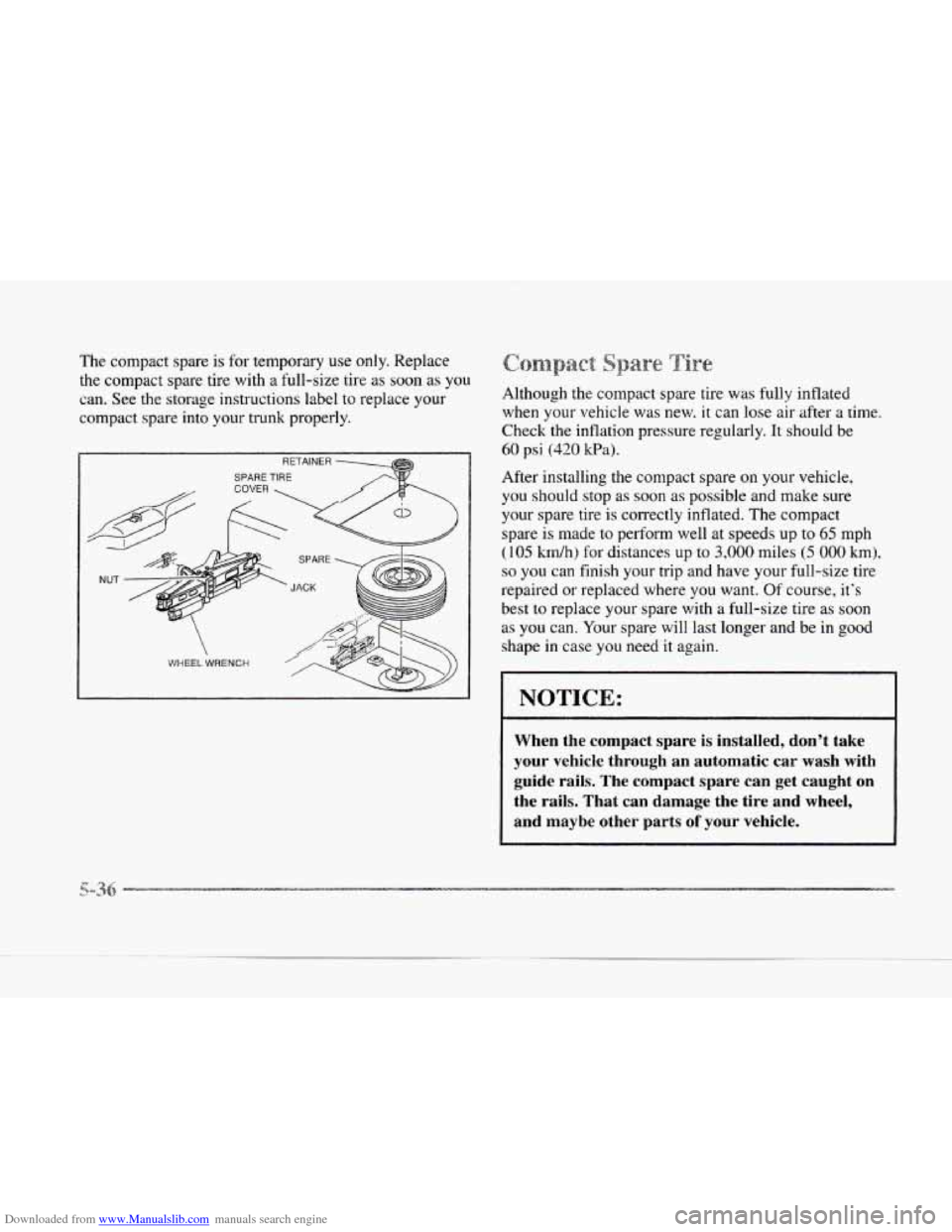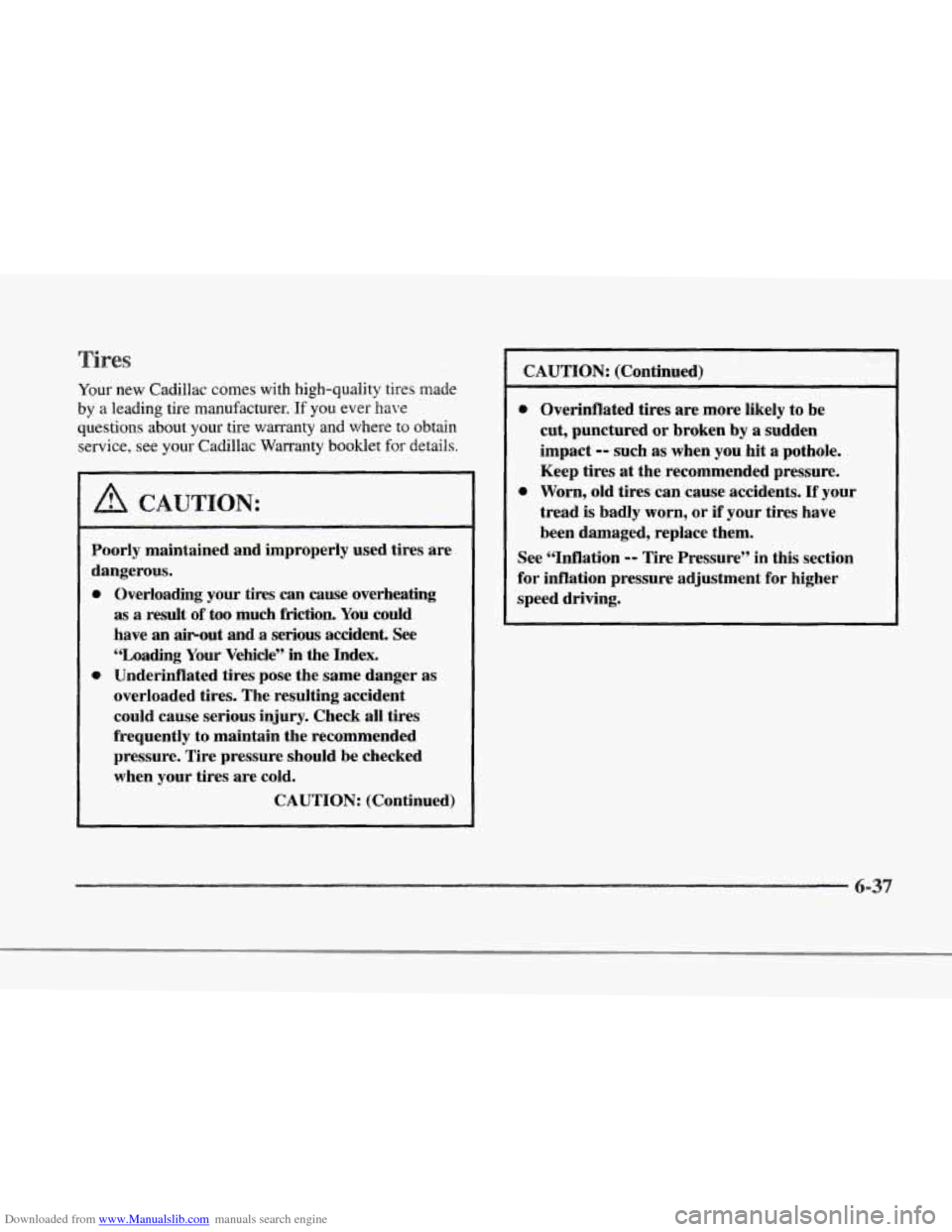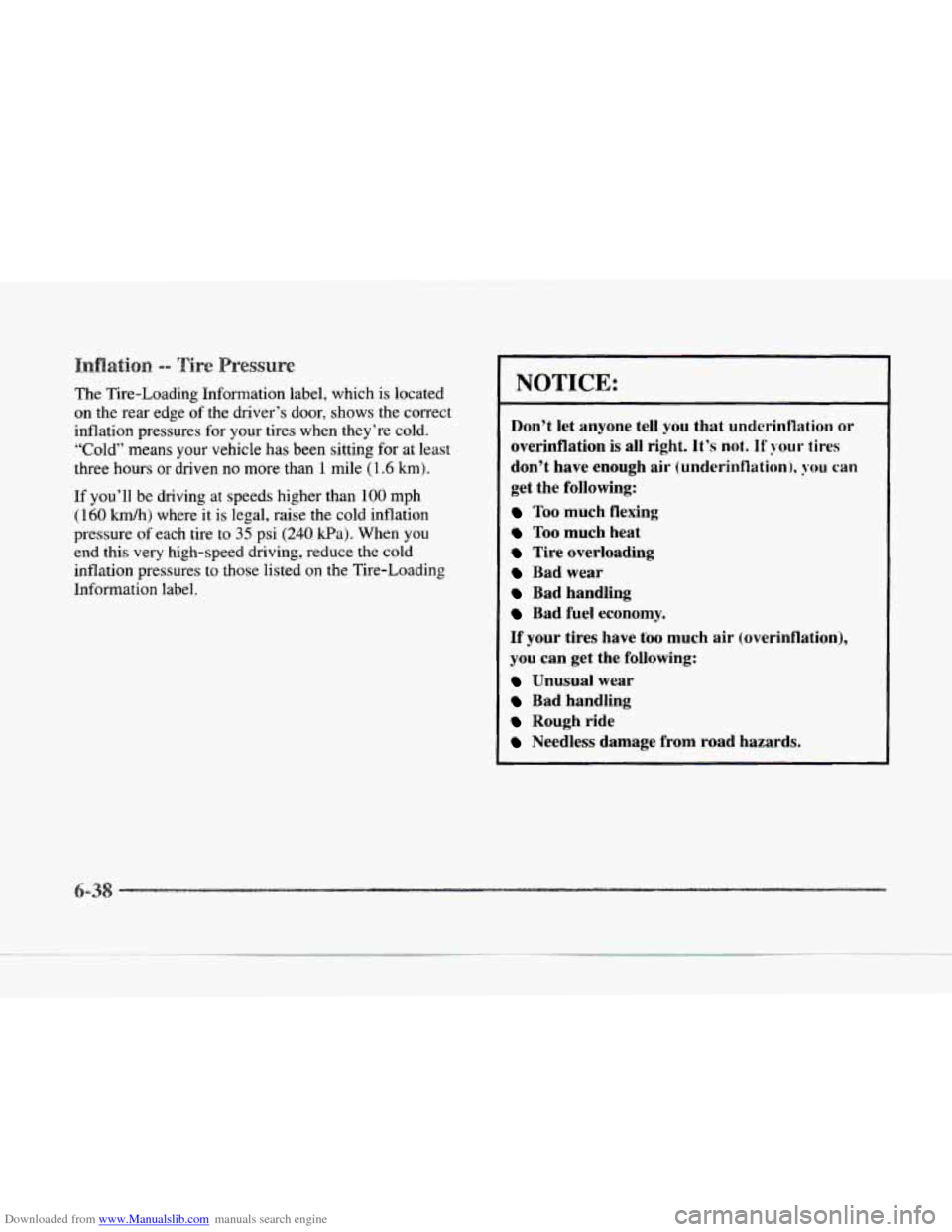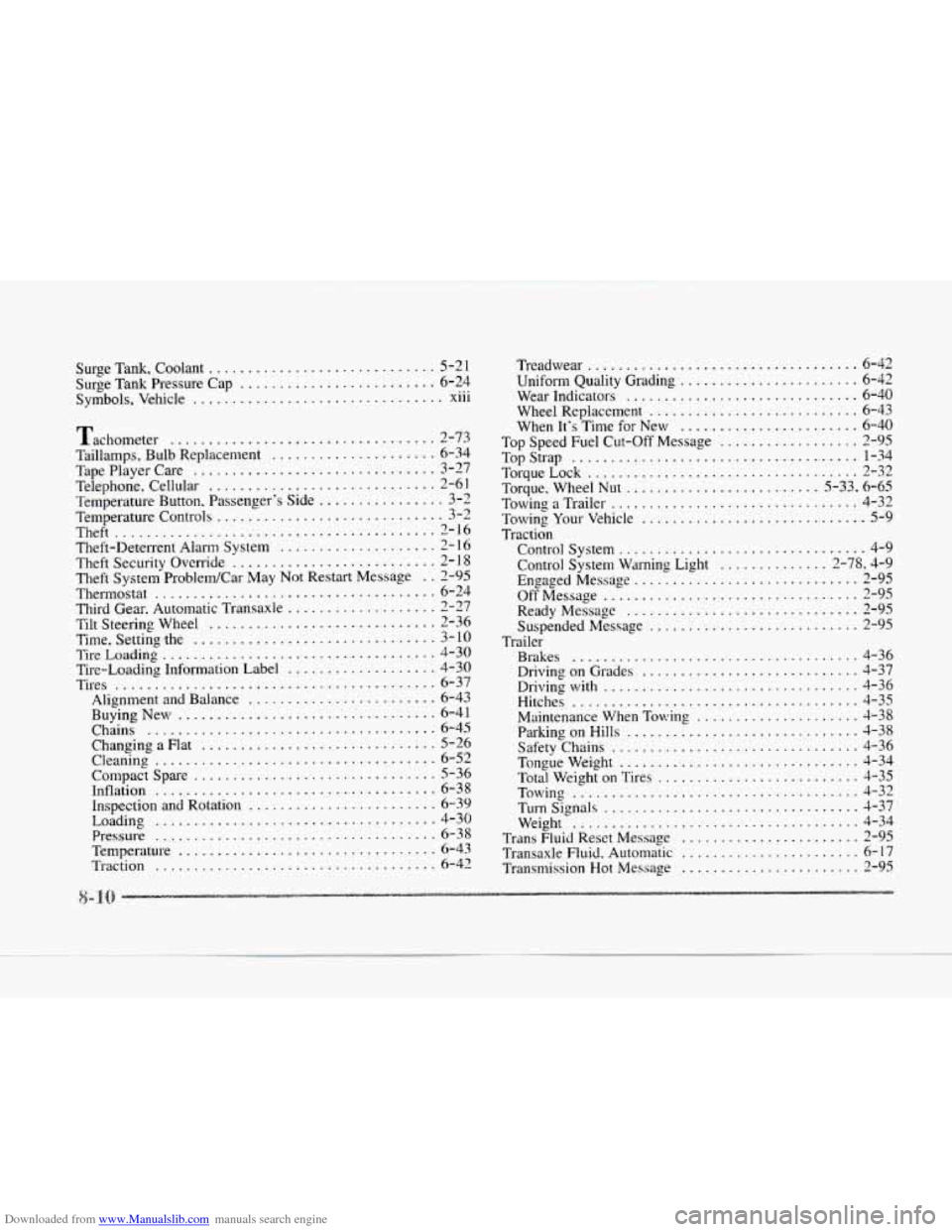1997 CADILLAC SEVILLE inflation pressure
[x] Cancel search: inflation pressurePage 221 of 370

Downloaded from www.Manualslib.com manuals search engine Run your engine only as long as you must. This saves
fuel. When you
run the engine, make it go a little faster
than just idle. That is, push the accelerator slightly. This
uses less fuel ’for the heat that
you get and it keeps the
battery charged.
You will need a well-charged battery to
restart the vehicle, and possibly for signaling later on
with your headlamps. Let the heater
run for awhile.
-*- _--
Then, shut the engine off and close the window almost
all the way to preserve the heat. Start the engine again
and repeat this only when you feel really uncomfortable
from the cold. But do it as little as possible. Preserve the
fuel as long as you can.
To help keep warm, you can get
out of the vehicle and do some fairly vigorous exercises
every half hour or
so until help comes.
TIRE-LOADING INFORMATION
VEHICLE CAP. WT.
FRT.
CTR. RR. TOTAL LBS.
MAX. LOADING & GVWR SAME AS VEHICLE
CAPACITY WEIGHT
XXX COLD TIRE
TIRE SIZE SPEED PRESSURE
RTG
PSIiKPa
FRT.
RR.
SPA.
IF TIRES ARE HOT, ADD 4PSIi28KPa
SEE OWNER’S MANUAL FOR ADDITIONAL
INFORMATION
Two labels on your vehicle show how much weight it
may properly carry.
The Tire-Loading Information label
found on the driver’s door tells you the proper size,
speed rating and recommended inflation pressures for
the tires on your vehicle. It also gives you important
information about the number
of people that can be in
your vehicle and the total weight that you can carry.
This weight is called the Vehicle Capacity Weight and
includes the weight
of all occupants, cargo and all
options not installed in the factory.
I
-3
Page 267 of 370

Downloaded from www.Manualslib.com manuals search engine The compact spare is for temporary use only. Replace
the compact spare tire with
a full-size tire as soon as you
can. See the storage instructions label to replace your
compact spars into your trunk properly.
RETAINER
SPARE TIRE
WHEEL WRENCH
Although the compact spare tire was fully inflated
when your vehicle was new.
it can lose air after a time.
Check the inflation pressure regularly.
It should be
60 psi (420 kPa).
After installing the compact spare on your vehicle,
you should stop as soon as possible and make sure
your spare tire
is correctly inflated. The compact
spare is made
to perform well at speeds up to 65 mph
(1 05 km/h) for distances up to 3,000 miles (5 000 km),
so you can finish your trip and have your full-size tire
repaired or replaced where
you want. Of course, it’s
best
to replace your spare with a full-size tire as soon
as you can. Your spar!: will last longer and be in good
shape in case you need it again.
NOTICE:
When the compact spare is installed, don’t take
your vehicle through an automatic car wash with guide rails.
The compact spare can get caught on
the rails. That can damage the tire and wheel,
and maybe other parts
of your vehicle.
I
L.
Page 308 of 370

Downloaded from www.Manualslib.com manuals search engine r
f 1;
I?
r
r
r
r
F
Your new Cadillac comes with high-quality tires made
by a leading tire manufacturer.
If you ever have
questions about your tire warranty and where
to obtain
service, see your Cadillac Warranty booklet
for details.
A CAUTION:
Poorly maintained and improperly used tires are
dangerous.
0 Overloading your tires can cause overheating
as a
result of too much friction. You could
have
an airout and a serious accident. See
‘Zoading Your Vehicle”
in the Index.
0 Underinflated tires pose the same danger as
overloaded tires. The resulting accident
could cause serious injury. Check all tires
frequently to maintain the recommended
pressure. Tire pressure should be checked
when your tires are cold.
CAUTION: (Continued)
CAUTION: (Continued)
0 Overinflated tires are more likely to be
cut, punctured
or broken by a sudden
impact
-- such as when you hit a pothole.
Keep tires at the recommended pressure.
0 Worn, old tires can cause accidents. If your
tread
is badly worn, or if your tires have
been damaged, replace them.
See “Inflation
-- Tire Pressure” in this section
for inflation pressure adjustment for higher
speed driving.
Page 309 of 370

Downloaded from www.Manualslib.com manuals search engine The Tire-Loading Information label, which is located
on the rear edge of the driver’s door, shows the correct
inflation pressures for your tires when they’re
cold.
“Cold” means your vehicle has been sitting for at least
three hours or driven no more than
1 mile (1.6 km).
If you’ll
be driving at speeds higher than 100 mph
(160 Wh) where it is legal, raise the cold inflation
pressure of each tire
to 35 psi (240 Pa). When you
end this very high-speed driving, reduce the cold
inflation pressures
to those listed on the Tire-Loading
Information label.
NOTICE:
Don’t let anyone tell you that underinflation or
overinflation is all right.
it’s not. If‘ your tires
don’t have enough air (underinflation),
you can
get the following:
Too much flexing
Too much heat
Tire overloading
Bad wear
Bad handling
Bad fuel economy.
If your tires have too much air (overinflation),
you can get the following:
Unusual wear
Bad handling
Rough ride
Needless damage from road hazards.
1
Page 310 of 370

Downloaded from www.Manualslib.com manuals search engine 1.
c
Check your tires once a month or more.
Don’t forget your compact spare tire. It should be at
60 psi (420 kPa).
Use a good quality pocket-type gage to check tire
pressure.
You can’t tell if your tires are properly inflated
simply by looking at them. Radial tires may look
properly inflated even when they‘re underinflated.
Be sure
to put the valve caps back on the valve
stems. They help prevent leaks by keeping out dirt
and moisture.
Tires should be rotated every
4,000 to 8,000 miles
( IO 000 to 13 000 km). Any time you notice unusual
wear, rotate your tires
as soon as possible and check
wheel alignment. Also check
for damaged tires or
wheels.
See “When It’s Time for New Tires” and
”Wheel Replacement” later
in this section for
more information. The purpose
of regular rotation is to achieve more
uniform wear for
all tires on the vehicle. The first
rotation
is the most important. See “Scheduled
Maintenance Services’‘
in thc Maintcnance Schedule
booklet for
schedulcd rota~io~~ inttwals.
When rotating your tires. al\vays use the con-t‘ct rotation
pattern
shown here.
Don’t include the compact spare tire
in your tire rotation.
After the tires have been rotated, adjust
the front and
rear inflation pressures
as show on the Tire-Loading
Information label. Make certain that all wheel
nuts
are properly tightened. See “Wheel Nut Torque” in
the Index.
6-3
Page 367 of 370

Downloaded from www.Manualslib.com manuals search engine Surge Tank. Coolant ............................. 5-21
Surge Tank Pressure Cap
......................... 6-24
Tachometer
.................................. 2-73
Taillamps.
Bulb Replacement ..................... 6-34
Tdpe Player Care
............................... 3-27
Telephone. Cellular
............................. 2-61
Tenlpemture Button. Passenger's Side ................ 3-2
Temperature Controls
............................. 3-2
Theft
......................................... 2-16
Theft-Deterrent Alarm System
.................... 2- 16
Theft Security Override
.......................... 2- 18
Third Gear . Automatic Transaxle ................... 2-27
Time. Setting the
............................... 3- 10
TireLoading ................................... 4-30
Tire-Loading Information Label
................... 4-30
Alignment and Balance
........................ 6-43
... Symbols. Vehicle ................................ x111
Theft System ProbledCar May Not Restart Message . . 2-95
Thermostat
.................................... 6-24
Tilt Steering Wheel ............................. - 7-36
Tires ......................................... 6-37
BuyingNew
................................. 6-41
Chains
..................................... 6-45
ChangingaFlat
.............................. 5-26
Cleaning
.................................... 6-52
Inflation
.................................... 6-38
Loading
.................................... 4-30
Pressure
.................................... 6-38
Traction
.................................... 6-42
Conlpact
Spare
............................... 5-36
Inspection and Rotation
........................ 6-39
Temperature
................................. 6-43
Treadwear ................................... 6-42
Uniform
Quality Grading ....................... 6-42
Wear Indicators
.............................. 6-40
Wheel Replacement ........................... 6-43
When
It's Time for New ....................... 6-40
Top Speed Fuel Cut-Off Message .................. 2-95
TopStrap
..................................... 1-34
TorqueLock
................................... 2-32
Torque . Wheel Nut ......................... 5-33.6-65
Towing a Trailer ................................ 4-32
Towing
Your Vehicle ............................. 5-9
Control System
................................ 4-9
Control System Warning Light .............. 2-78. 4-9
Engaged Message
............................. 2-95
Suspended Message
............................ 2-95
Driving on Grades ............................ 4-37
Driving with
................................. 4-36
Maintenance When Towing
..................... 4-38
Safety Chains
................................ 4-36
Tongue Weight ............................... 4-33
Total Weight on Tires .......................... 4-35
Towing ..................................... 4-32
Turn Slgnals
................................. 1-37
Trans
Fluid Reset Message ....................... 2-95
Transaxle Fluid
. Automatic ....................... 6-17
Transmission Hot Message
....................... 2-95
Traction
OffMessage
................................. 2-95
Ready Message .............................. 2-95
Trailer Brakes
..................................... 4-36
Hitches
..................................... 4-35
ParkingonHills
.............................. 4- 38
Weight
..................................... 4-34